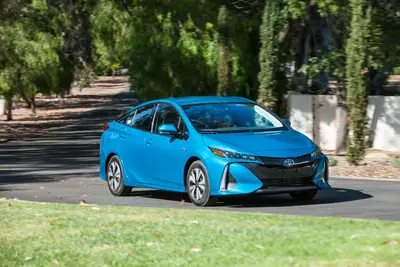First Drive Review: 2017 Toyota Prius Prime by Henny Hemmes +VIDEO
By Henny Hemmes
Senior European Editor
THE AUTO CHANNEL
• SEE ALSO: Toyota Research and Buyers Guide
 Toyota Prius Prime |
OJAI, CA - October 4, 2016: Gone is the Prius Plug-in, welcome to the Prius Prime! During our first test drive in the hills surrounding the Ojai Valley, the PHEV that is a variant of the fourth generation Prius surprised us in different ways.
It is just clever thinking of Toyota to give the new PHEV-model a new name, just to make it clear that it has nothing to do with its predecessor. The former, introduced some four years ago, could not impress with a short electric range and the gasoline engine taking over before you could count to ten.
With the arrival of the 2017 Prius Prime, the old model can be quickly forgotten. With an 8.8 kWh lithium-ion battery, Toyota promises an electric range of 22 miles up to 84 mph and a combined range of more than 600 miles.
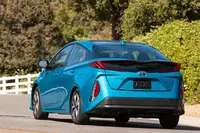 Toyota Prius Prime |
To get down to business at once: during our first test route of 19 miles on winding roads up and downhill, the Prime remained in electric mode all the way. No, no, we did not drive with an imaginary egg beneath the accelerator pedal. And understandably, we did not reach 80 mph either.
After touching base, we went through Ojai into the valley. Ten miles later the gas engine took over and the car went into hybrid mode. It was only that my colleague constantly kept an eye on the display that shows the status of electric power, else we’d have hardly noticed the transition. We saw a fuel consumption of 52.3 mpg on our display, which is fair, according to the engineers upon our return to the base station.
Around 25 miles to a charge is good for short commutes and doubling the range by charging at the mall or at work, it is not bad at all. Recharging the 8.8 kWh battery at 240 volts takes approximately 2 hours and 10 minutes. At home, with a standard 120 volts, it takes up to 5.5 hours.
 Toyota Prius Prime |
Last year, the new Prius surprised us with its dynamic character. Thanks to the new TNGA-platform with a 60 per cent higher torsion stiffness it feels solid and is quiet. Steering into bends was precise and there was hardly any understeer. That also goes for the Prime, notwithstanding the fact that the plug-in model puts extra pounds in the scales, mainly due to the 265 pounds of the new 95 cell lithium-ion battery. The larger size of the battery does reduce the cargo capacity by some 7 cu-ft and blocks the possibility of a third seat on the second row.
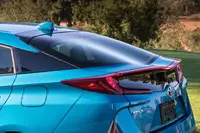 Toyota Prius Prime |
On the road, you can feel the car is heavier (3,375 pounds for the tested Advanced model), but that does not negatively influence handling. On the contrary, there is less body roll. Toyota has compensated the higher weight with optimized spring rates at the front and rear, a different damper set up with a new piston valve up front and optimized stabilizer characteristics. Another weight saver is the CFRP hatch that has no wiper because of the curved design.
 Prius chief engineer, Kouji Toyoshima |
The electric drivetrain of the Prime responds quickly and the electric power steering gives a solid feel and good feedback going into tight bends. Prius chief engineer, Kouji Toyoshima told me that apart from the low center of gravity of the car, the weight lies now a bit more on the rear wheels. The compact CVT runs smooth but can be heard when accelerating.
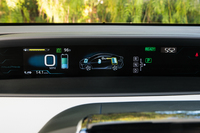 Toyota Prius Prime |
Just as the Prius hybrid the Prime is powered by Toyota’s Hybrid Synergy Drive powertrain, which combines the output of the 1.8-liter gasoline engine and the dual motor generator through a planetary-type continuously variable transmission, it's much the same as in the regular Prius. However, the electric motors are set up in a different way. The combined output for hybrid system is 121 hp/90 kW. A smaller, lighter, quieter hybrid system water pump and an exhaust heat recirculation system quickly warm up the engine, elongating the electric range.
The Prime offers three drive modes, EV, HV, and EV Auto mode. EV is the default mode when charged and if not, it switches to Hybrid node just like a regular Prius.
EV Auto mode can be selected provided there is EV charge. This mode stretches the charge by using the gas engine when accelerating so that enough charge remains for less demanding situations.
The other modes are normal, power, and eco. Power sharpens throttle response. And Eco does the opposite. The latter we did not use. Toyota says that acceleration times of the regular Prius and the Prime are the same (10.5 seconds), but the Prime is faster under 50 mph.
The Prius Prime offers a stable, unperturbed character with good handling and a comfortable ride. For those who like the range and like the styling of the Prime, would not have to think long. In my city, The Hague in The Netherlands, a plug-in may not be worth the extra money. Almost everybody has to park along the curb so that charging ‘at home’ depends on the availability of charging stations. In streets like mine, that is a protected city view, there are a few, but mostly taken for a long time. In situations like this, the regular Prius makes life easier
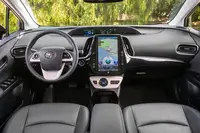 Toyota Prius Prime |
Later this week I will talk about design and equipment, including the vertical 11.6-inch high resolution video screen, that is standard in the Prime Premium ($29,965) and loaded Prime Advanced ($33,965) trim levels.
The base model, the Prime Plus has a starting price of $27,965.
"We received final estimated fuel efficiency figures from the EPA and are happy to tell you that all MPG figures remained as we projected with the exception of MPGe, where we far exceeded our projection of 124 with an official EPA estimate of 133 MPGe! This updated figure of 133 MPGe makes the Prius Prime the undisputed industry leader for ALL vehicle types in MPGe.



